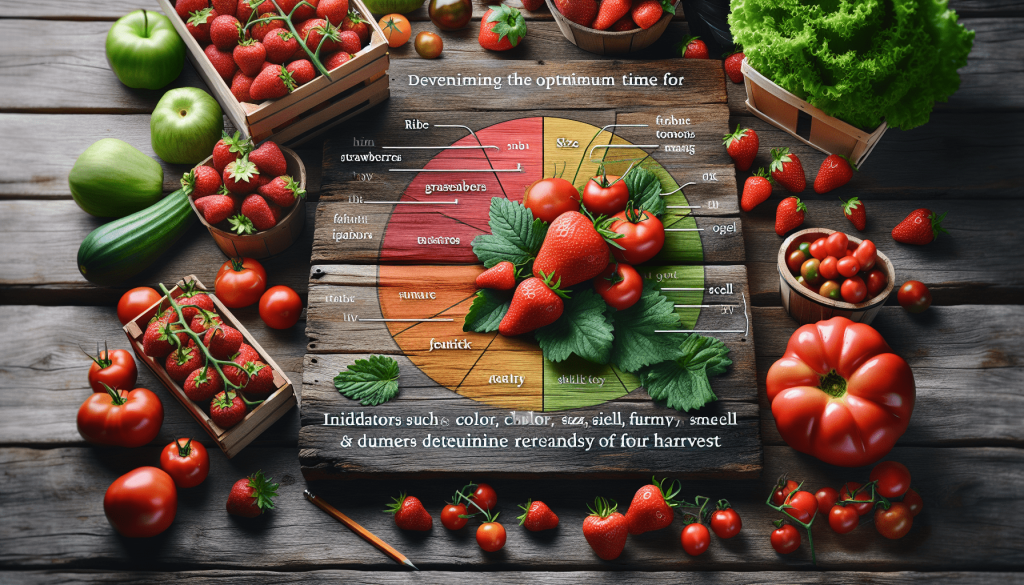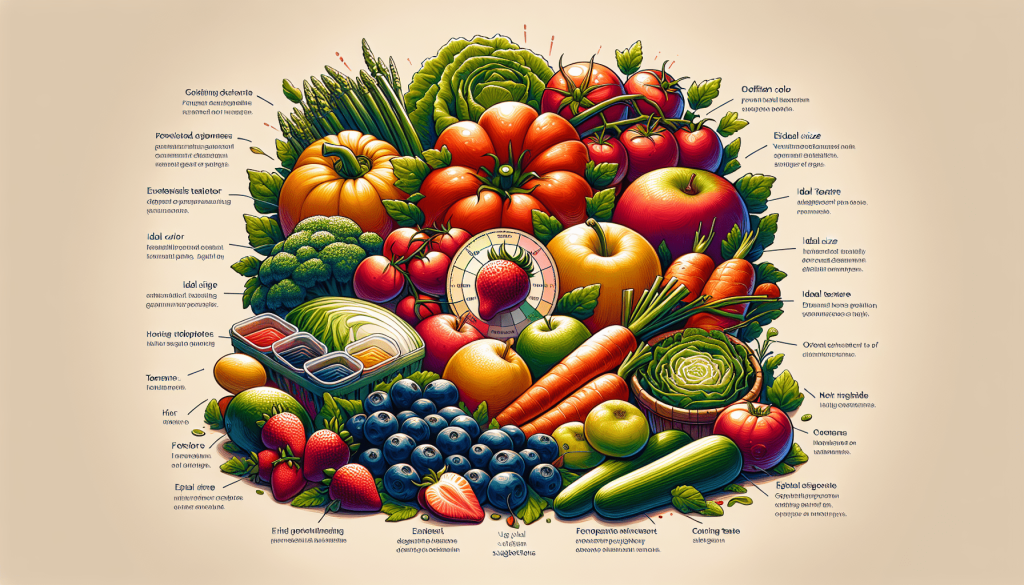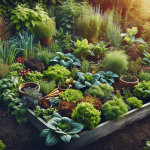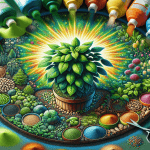This post may contain affiliate links. As an Amazon Associate, we may earn commissions from qualifying purchases.
Have you ever wondered when the perfect time to harvest your fruits and vegetables is? It can be quite a dilemma to determine the exact moment when your crop is at its peak flavor and nutritional value. Luckily, there are several indicators to look out for that will guide you in the right direction. From observing color changes to assessing the texture, this article will provide you with valuable insights on how to know when your fruits and vegetables are ready to harvest. So get ready to embark on a fruitful journey of harvesting and enjoy the satisfaction of picking your own homegrown produce at its absolute best!

Visual Signs
When it comes to determining the readiness of fruits and vegetables for harvest, visual signs play a crucial role. By observing color change, size and shape, and shine or glossiness, you can gain valuable insights into the maturity and quality of the produce.
Color Change
One of the most apparent visual signs of ripeness is a color change. Different fruits and vegetables exhibit different color transformations as they mature. For example, bananas turn from green to yellow, while tomatoes change from green to red. By keeping an eye on color change, you can ensure that you harvest your crops at their peak flavor and nutritional content.
Size and Shape
Size and shape are also reliable indicators of when to harvest your produce. As fruits and vegetables grow and reach maturity, they generally increase in size and develop a specific shape. Monitoring these changes can give you a good idea of when the crop is ready to be harvested. However, it’s important to refer to specific guidelines for each plant, as size and shape may vary depending on the variety.
Shine or Glossiness
Another visual sign to look out for is shine or glossiness. As fruits and vegetables ripen, they often develop a shiny or glossy appearance. This can be observed in fruits like apples, which become more vibrant and lustrous as they mature. The shine or glossiness indicates that the produce has achieved optimum ripeness and is ready to be harvested and enjoyed.
Tactile Indicators
Apart from visual cues, tactile indicators can offer valuable information about the readiness of fruits and vegetables for harvest. By examining firmness and texture, you can determine the ideal time to pick your crops.
Firmness
Firmness is an important tactile indicator to consider. Gently press the fruit or vegetable with your fingers to assess its firmness. A ripe produce should yield slightly to pressure but not be too soft or mushy. Different crops have different levels of firmness when ripe, so it’s essential to educate yourself about the specific variety you are growing.
Texture
Texture is another tactile aspect to examine. Ripe fruits and vegetables tend to have a smooth and consistent texture. If you notice any signs of wrinkling, bruising, or texture irregularities, it may indicate over-ripeness or spoilage. It’s crucial to handle the produce with care during the examination to ensure you don’t damage or bruise it unintentionally.
Smell and Scent
The sense of smell is a powerful tool in determining the ripeness of fruits and vegetables. By paying attention to the aroma and fragrance, you can detect the peak moment to harvest your crops.
Aroma
Fruits and vegetables emit distinct aromas as they ripen. Some become more fragrant and sweet, while others develop a more earthy or pungent scent. For example, ripe melons have a delightful, sweet aroma, while basil leaves emanate a strong and pleasant fragrance. Take a moment to smell the crop, and if the aroma is strong and inviting, it’s a good indication that it is ready to be harvested.
Fragrance
Similar to aroma, the fragrance of fruits and vegetables can offer valuable insights. Some crops, like berries, emit a strong and sweet fragrance when fully ripe. On the other hand, vegetables such as onions may have a sharp and distinct odor when they are at their peak readiness. By familiarizing yourself with the specific scents of different crops, you can confidently determine their ripeness using your sense of smell.
Sound Clues
Although not as commonly used as visual or tactile indicators, sound clues can also be utilized to assess the readiness of certain fruits and vegetables.
Thumping
Thumping is a technique commonly employed to determine the ripeness of melons, particularly watermelons. By tapping the rind of a watermelon and listening to the sound it produces, you can gain insight into its ripeness. A ripe watermelon will give off a deep and hollow sound, while an underripe one will sound more solid and dull. Thumping can also be used for other fruits, like pumpkins or cantaloupes, to gauge their readiness.
Rustling
For crops that have a protective husk or shell, such as corn or peas, rustling can be a useful sound clue. Squeezing the husk or shaking the pod gently should produce a rustling or rattling sound if the produce is fully mature. However, it’s important to remember that sound clues should be used in conjunction with other indicators, as they may not be applicable to all fruits and vegetables.

Taste Testing
At times, the best way to determine the readiness of certain fruits and vegetables is to conduct a taste test. By sampling the produce, you can assess factors such as flavor development, sweetness or tartness, and overall taste quality.
Flavor Development
As fruits and vegetables mature, their flavors develop and intensify. A taste test can help you evaluate the complexity and depth of flavor. For instance, a tomato that has reached peak ripeness will have a rich, sweet, and well-balanced taste. On the other hand, an underripe tomato may lack sweetness and have a tart or unripe flavor. By tasting your crops, you can ensure that you harvest them at the point of maximum flavor.
Sweetness or Tartness
Sweetness or tartness is an essential aspect of many fruits and vegetables. By sampling the produce, you can gauge the desired level of sweetness or tartness that indicates ripeness. For example, with berries, a ripe fruit will exhibit a pleasant balance between sweetness and tartness. Conversely, an underripe fruit might taste overly tart, while an overripe one could be excessively sweet. Taste testing allows you to fine-tune your harvest and ensure you pick your crops at their peak sweetness.
Internal Ripeness
While external signs are helpful, some fruits and vegetables require you to assess their internal characteristics to determine their ripeness. Seed maturity and flesh color are two important factors to consider.
Seed Maturity
For fruits with seeds, such as melons or squash, evaluating the seed maturity is crucial. Cut the fruit open and examine the seeds. Fully mature seeds are well-formed and firm. If the seeds are small, pale, or underdeveloped, it’s an indication that the produce is still in the early stages of maturation. Checking the seed maturity can help you determine if the fruit is ripe or needs more time to develop.
Flesh Color
The color of the flesh is another internal indicator of ripeness for certain fruits and vegetables. By slicing open the produce, you can assess the color against a reference guide. For example, avocados should have a vibrant green or yellowish-green color, depending on the variety, when they are ripe. If the flesh appears pale or has a greenish tint, it suggests that the fruit is not yet fully ripened. Paying attention to the flesh color can help you make informed harvesting decisions.
Time to Maturity
Understanding the estimated time to maturity is crucial for successful harvesting. By knowing the expected days to harvest and the overall timeframe, you can plan your gardening activities accordingly.
Days to Harvest
Each plant has a specific number of days from planting to reach maturity. It’s essential to refer to seed packets or gardening resources to determine the average days to harvest for different crops. Factors such as temperature, sunlight, and other environmental conditions can affect this timeframe. By keeping track of the days to harvest, you can anticipate when your crops are likely to be ready and plan your harvest accordingly.
Expected Harvest Time
In addition to the days to harvest, it’s important to be aware of the expected harvest time for each crop. This refers to the particular season or specific month when the crop is traditionally harvested. This information can be found in plant-specific guides, gardening books, or agricultural resources. Understanding the expected harvest time helps you align your gardening efforts with the natural growth cycle of the plants, ensuring optimal yield and flavor.
Harvest Guides
To enhance your knowledge of harvesting, harvest guides provide invaluable information about specific fruits and vegetables. These guides offer insights into the ideal time to harvest, as well as tips on post-harvest handling and storage.
Plant Specific Guides
Plant specific guides provide comprehensive details about a particular crop, including its growth stages, common visual indicators for maturity, and ideal harvest time. These guides may also include advice on pest management, optimal watering techniques, and specific care instructions. By consulting plant specific guides, you can become a more informed gardener and make better decisions about when to harvest your produce.
Farmer’s Almanac
The Farmer’s Almanac is an excellent resource for understanding the seasonal cultivation and harvest cycles of various crops. It provides long-standing wisdom and practical advice for gardeners, including information on planting dates, expected harvest times, and other factors that impact crop growth. The Farmer’s Almanac is a trusted source that can guide you throughout the gardening season, from seed selection to harvest and beyond.
Weather and Environmental Factors
Understanding the influence of weather and environmental factors on harvest readiness is crucial for successful gardening. Temperature and rainfall play significant roles in the growth and development of fruits and vegetables.
Temperature
Temperature plays a crucial role in determining the ripening process of most crops. Different crops have varying temperature requirements for optimal growth and ripening. Extreme temperatures, either too hot or too cold, can negatively impact the quality and timing of the harvest. By monitoring the temperature and understanding the specific needs of your crops, you can ensure they have the right conditions for healthy growth and proper ripening.
Rainfall
Rainfall, or the lack thereof, can also affect the readiness of fruits and vegetables for harvest. Adequate water availability is essential for the growth and maturation of crops. Insufficient rainfall may lead to stunted growth or underdeveloped produce, while excessive rain can cause damage or increased susceptibility to disease. Monitoring rainfall and providing appropriate irrigation can help ensure that your crops reach their full potential and are ready for harvest.
Keeping Records
Maintaining accurate records is a valuable practice for any gardener. By documenting important details about your crops, such as growth stage and previous harvest dates, you can gain insights into the optimal harvest time and make informed decisions in subsequent seasons.
Growth Stage
Keeping track of the growth stage of your plants helps you gauge their progress and anticipate their eventual readiness for harvest. Noting the different stages, such as seed germination, flowering, or fruit formation, allows you to compare their growth to previous seasons and evaluate if they are on track. Understanding the growth stage enables you to estimate when the fruits and vegetables will be fully mature and ready for harvesting.
Previous Harvest Dates
Recording the dates of previous harvests offers valuable historical data. By comparing the dates of past harvests with current crops, you can identify patterns or variations in ripening times due to different weather conditions, plant care practices, or planting times. This information allows you to make informed decisions about when to expect future harvests and adjust your planting or gardening strategies accordingly.
In conclusion, determining the readiness of fruits and vegetables for harvest requires a multi-sensory approach. By utilizing visual signs, such as color change, size, and shine, along with tactile indicators like firmness and texture, you can assess external characteristics. Smell and scent offer insights into aroma and fragrance, while sound clues, like thumping and rustling, provide additional cues. Taste testing allows you to evaluate flavor development and sweetness or tartness. For some crops, internal ripeness indicators such as seed maturity and flesh color are crucial. Understanding the estimated time to maturity and considering weather and environmental factors are also essential. Through the use of harvest guides, like plant specific guides and the Farmer’s Almanac, you can gain knowledge about ideal harvest times and post-harvest handling. Lastly, keeping accurate records of growth stages and previous harvest dates ensures continuous learning and informed decision-making. By combining these approaches, you can become a skilled and successful gardener, reaping the rewards of well-timed and flavorful harvests.








